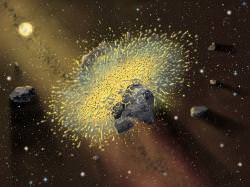Astronomers are slowly piecing together the earliest phases of our Solar System’s history. At some point, tiny particles of dust clung together forming larger and larger boulders and eventually even mountain-sized chunks of rock. Researchers from UC Davis have pegged the date that this occurred to 4.568 billion years ago, give or take a few million years.
The evolution of the Solar System is believed to have gone through several distinct stages. The first stage occurred when tiny particles of interstellar dust linked up, created boulders, and leading up to the mountain-sized rocks.
In the second stage, these mountains collected into about 20 Mars-sized objects. In the third and final stage, these mini-planets smashed into one another, eventually leading to the large planets we have today. The dates of the second and third stages are fairly well known, but the timing of the first stage has largely been a mystery.
To get an idea of when that first stage took place, researchers from UC Davis analyzed a particular kind of meteorite, called carbonaceous chondrites. These represent some of the oldest material in the Solar System.
They found that the meteorites have very stable ratios of certain elements, which can allow them to be dated. Since the rocks never got large enough to heat up from radioactive decay, they’re cosmic sediments from the early Solar System.
The UC Davis researchers estimated the timing of their formation to 4.568 billion years ago, ranging from 910,000 years earlier or 1.17 million years later.
“We’ve captured a moment in history when this material got packed together,” said Qing-zhu Yin, assistant professor of geology.
The work is published in the Dec. 20 issue of Astrophysical Journal Letters.
Original Source: UC Davis News Release

